Biology 101 Quiz 4 Questions and Answers elaboration | 100% Guaranteed Pass
Document Content and Description Below
UMUC; BIO. 101 QUIZ: 4, FINAL SCORE: 100 Question 1 (5 points) Saved At which phase(s) is it preferable to obtain chromosomes to prepare a karyotype? Question 1 options: early prop... hase anaphase late anaphase or early telophase late prophase or metaphase Question 2 (5 points) All of the following are characteristics of cancer cells EXCEPT . Question 2 options: unmutated DNA ability to metastasize angiogenesis unregulated mitosis no apoptosis Question 3 (5 points) In humans, the number of tetrads formed during mitosis is . Question 3 options: 23 46 0 Question 4 (5 points) Mitosis in humans usually results in the formation of . Question 4 options: 2 diploid cells 4 diploid cells 2 haploid cells 4 haploid cells Sperm or egg cells Question 5 (5 points) What stage does cytokinesis generally overlap with in the typical cell cycle? Question 5 options: S phase prophase telophase anaphase metaphase Question 6 (5 points) During of meiosis, sister chromatids are separated. Question 6 options: prophase II anaphase II telophase I anaphase I Previous PageNext Page Question 7 (5 points) What is the first stage of meiosis during which a cell is considered haploid? Question 7 options: Metaphase I Anaphase I Metaphase II Prophase II Telophase I Question 8 (5 points) When comparing mitosis with meiosis, which of the following statements is incorrect? Question 8 options: DNA replication occurs in a cell before both mitotic and meiotic cell division. The end result of mitosis is the production of two identical haploid daughter cells, whereas the end result of meiosis is the production of four non-identical haploid cells. Metaphase of meiosis differs from that of mitosis because homologous pairs line up only during meiosis. The function of mitosis is to produce somatic cells, such as skin, blood, and other tissues, whereas meiosis produces gametes. Question 9 (5 points) Four of the five answers listed below are related by a common phase of mitosis. Select the exception. Question 9 options: Spindle microtubules disappear Nuclear envelope re-forms Chromosomes decondense Chromosomes separate Question 10 (5 points) A animal cell has just completed telophase, which of the following would you expect to see? Question 10 options: An empty cell. Individual chromatids separating. Formation of vesicles at the metaphase plate. The formation of two genetically identical cells. Question 11 (5 points) In which phase of mitosis does spindle microtubules attach to kinetochores? Question 11 options: Metaphase Prometaphase Telophase Anaphase Question 12 (5 points) Why did the F1 offspring of Mendel's classic pea cross always look like one of the two parental varieties? Question 12 options: Codominance The traits blended together during fertilization. One phenotype was completely dominant over another. Question 13 (5 points) A plant that produces dark brown seeds is crossed with a plant that produces light brown seeds. The seeds of all of the offspring are light brown. What is the most likely explanation? Question 13 options: The light brown allele is dominant. All of the offspring are homozygous light brown. The dark brown allele is dominant. This is an example of incomplete dominance Question 14 (5 points) What is a test cross? Question 14 options: A cross of two pure-breeding forms to find out which form of a gene is dominant. A cross between two unknown forms to determine their genotypes. A cross between an offspring and its parent. A cross of an F1 hybrid to an individual that is homologous recessive. Question 15 (5 points) A woman with blue eyes (bb) and a man with brown eyes (Bb) has a child. What is the percentage change that the child will have blue eyes? Question 15 options: 0% 25% 50% Question 16 (5 points) An organism is described as BB: blue. The BB is the organism's [A] ; blue is the organism's [B] ; and the organism is [C] . Question 16 options: [A] phenotype; [B] genotype; [C] sex linked [A] karyotype; [B] hybrid; [C] recessive [A] genotype; [B] phenotype; [C] heterozygous [A] genotype; [B] phenotype; [C] homozygous Question 17 (5 points) Why are males more often affected by sex-linked traits than females? Question 17 options: Males only have one X chromosome. Females only have one Y chromosome Males have two X chromosomes Females have two Y chromosomes Question 18 (5 points) Which of the following statements about autosomes is true? Select all that apply Question 18 options: Autosomes determine gender. Autosomes vary between males and females. Humans have 22 pairs of autosomes Question 19 (5 points) Use the figure and the following description to answer the questions below. Plants with at least one allele D have dark green leaves, and plants with the homozygous recessive dd genotype have light green leaves. A homozygous dark-leaved plant is crossed with a plant with light-green leaves, and the F1 offspring is allowed to self-pollinate. The predicted outcome of the F2 is diagrammed in the Punnett square shown in the figure, where 1, 2, 3, and 4 represent the genotypes corresponding to each box within the square. Which of the boxes marked 1-4 correspond to plants with light green leaves? Question 19 options: 1 only 1 and 2 4 only 1, 2, and 3 Question 20 (5 points) What is polygenic inheritance? Question 20 options: One trait is controlled by one gene. One traits is controlled by many genes. One gene masking or interfering with the expression of another gene. Question 1 (5 points) Saved A karyotype . Question 1 options: cannot be used to identify individual chromosomes beyond the fact that two chromosomes are homologues. of a normal human cell shows 48 chromosomes. is a photograph of cells undergoing mitosis during anaphase. compares one set of chromosomes to another. Question 2 (5 points) A cell is arrested during mitosis. At this stage, distinct chromatids are visible at opposite poles of the cell. Which stage of mitosis does this describe? Question 2 options: Prophase Anaphase Telophase Metaphase Interphase Question 3 (5 points) If the cell whose nuclear material is shown in the figure continues toward completion of mitosis, which of the following events would occur next? Question 3 options: cell membrane synthesis formation of telophase nuclei synthesis of chromatids nuclear envelope breakdown Question 4 (5 points) Mitosis in humans usually results in the formation of . Question 4 options: 2 diploid cells 4 diploid cells 2 haploid cells 4 haploid cells Sperm or egg cells Question 5 (5 points) What is a cleavage furrow? Question 5 options: A ring of vesicles forming a cell plate The separation of divided prokaryotes A groove in the plasma membrane between daughter nuclei The metaphase plate where chromosomes attach to the spindle The space that is created between two chromatids during anaphase Question 6 (5 points) After telophase I of meiosis, the chromosomal makeup of each daughter cell is . Question 6 options: diploid, and the chromosomes are each composed of a single chromatid. diploid, and the chromosomes are each composed of two chromatids. haploid, and the chromosomes are each composed of a single chromatid. tetraploid, and the chromosomes are each composed of two chromatids. Question 7 (5 points) If a cell has completed the first meiotic division and is just beginning meiosis II, which of the following is an appropriate description of its contents? Question 7 options: It has half the amount of DNA as the cell that began meiosis. It has one-fourth the DNA and one-half the chromosomes as the originating cell. It is identical in content to another cell from the same meiosis. It has half the chromosomes but twice the DNA of the originating cell. It has the same number of chromosomes but each of them has different alleles than another cell from the same meiosis. Question 8 (5 points) In which process is chromatids separated from each other? Question 8 options: Mitosis only. Meiosis II only. Meiosis I only. Mitosis and meiosis II. Question 9 (5 points) Four of the five answers listed below assist in chromosome movement. Select the exception. Question 9 options: Nuclear envelope Kinetochores Centriole Centromere Question 10 (5 points) If the cell whose nuclear material is shown in the figure below continues toward completion of mitosis, which of the following events would occur next? Question 10 options: Nuclear envelope breakdown Spindle fiber formation Cell membrane synthesis around the two new cells Sister chromatids move to opposite poles Question 11 (5 points) For anaphase to begin, which of the following must occur? Question 11 options: Chromatids must lose their kinetochores. Cohesin must attach the sister chromatids to each other. Cohesin must be cleaved enzymatically. Kinetochores must attach to the metaphase plate. Spindle microtubules must begin to depolymerize. Question 12 (5 points) For Mendel's explanation of inheritance to be correct, Question 12 options: genes could not be transmitted independently of each other. which gametes combine at fertilization had to be due to chance. only organisms with one copy of each chromosome would demonstrate inheritance patterns. Question 13 (5 points) Which of these crosses will only produce heterozygous offspring? Question 13 options: Aa × Aa Aa × aa AA × aa AA × Aa Question 14 (5 points) Which term is used to describe genes that are located physically close to each other on the same chromosome? Question 14 options: Genome Linkage Karyotype Allele Question 15 (5 points) A man and a woman, both with brown eyes (Bb), has a child. What is the percentage change that the child will have blue eyes? Question 15 options: 0% 25% 50% Question 16 (5 points) An organism is described as RR: red. The RR is the organism's [A] ; red is the organism's [B] ; and the organism is [C] . Question 16 options: [A] phenotype; [B] genotype; [C] sex linked [A] karyotype; [B] hybrid; [C] recessive [A] genotype; [B] phenotype; [C] heterozygous [A] genotype; [B] phenotype; [C] homozygous Question 17 (5 points) A human X-linked gene is Question 17 options: found only in males. more frequently expressed in females. only transmitted from father to son. found on the X chromosome. Question 18 (5 points) Which of the following statements about sex chromosomes is true? Select all that apply Question 18 options: Sex chromosomes determine gender. Sex chromosomes vary between males and females. Sex chromosomes carry some genes that may have nothing to do with sex or gender. Question 19 (5 points) Use the figure and the following description to answer the questions below. Plants with at least one allele D have dark green leaves, and plants with the homozygous recessive dd genotype have light green leaves. A homozygous dark-leaved plant is crossed with a plant with light-green leaves, and the F1 offspring is allowed to self-pollinate. The predicted outcome of the F2 is diagrammed in the Punnett square shown in the figure, where 1, 2, 3, and 4 represent the genotypes corresponding to each box within the square. Which of the boxes marked 1-4 correspond to plants with dark green leaves? Question 19 options: 1 only 1 and 2 4 only 1, 2, and 3 Question 20 (5 points) What is epistasis? Question 20 options: One trait is controlled by one gene. One traits is controlled by many genes. One gene masking or interfering with the expression of another gene. [Show More]
Last updated: 1 year ago
Preview 1 out of 18 pages
Instant download

Buy this document to get the full access instantly
Instant Download Access after purchase
Add to cartInstant download
Reviews( 0 )
Document information
Connected school, study & course
About the document
Uploaded On
May 10, 2022
Number of pages
18
Written in
Additional information
This document has been written for:
Uploaded
May 10, 2022
Downloads
0
Views
35






.png)






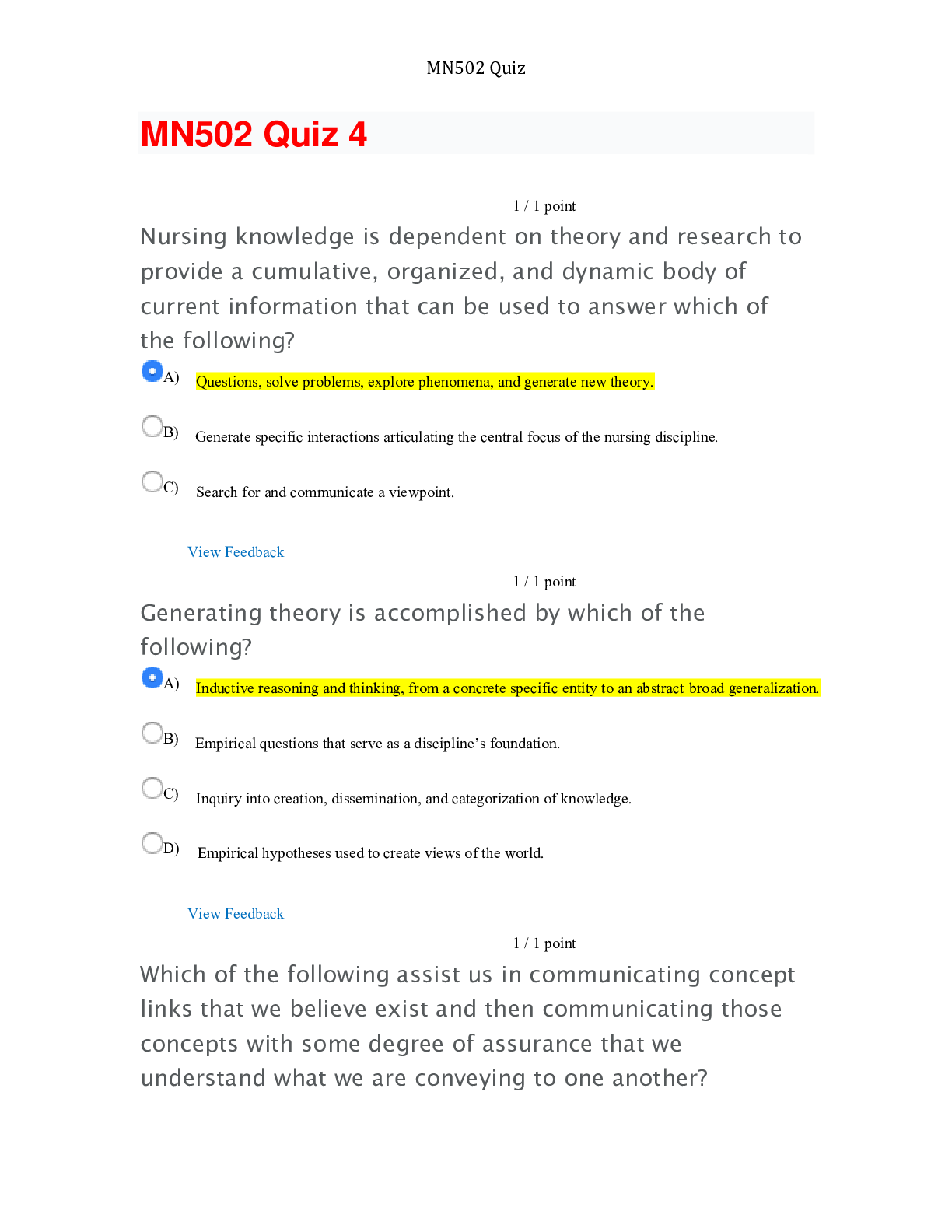
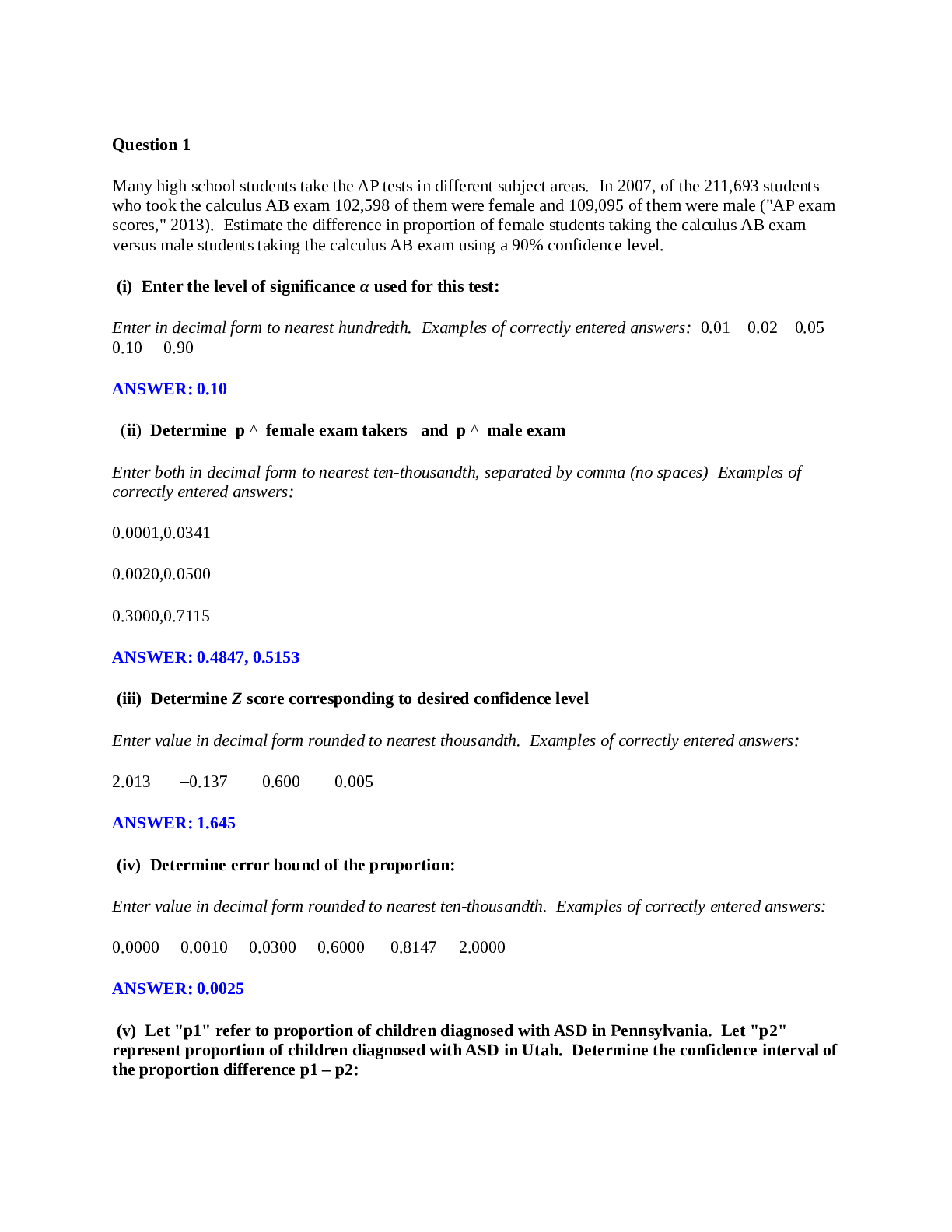

.png)
 60566.png)
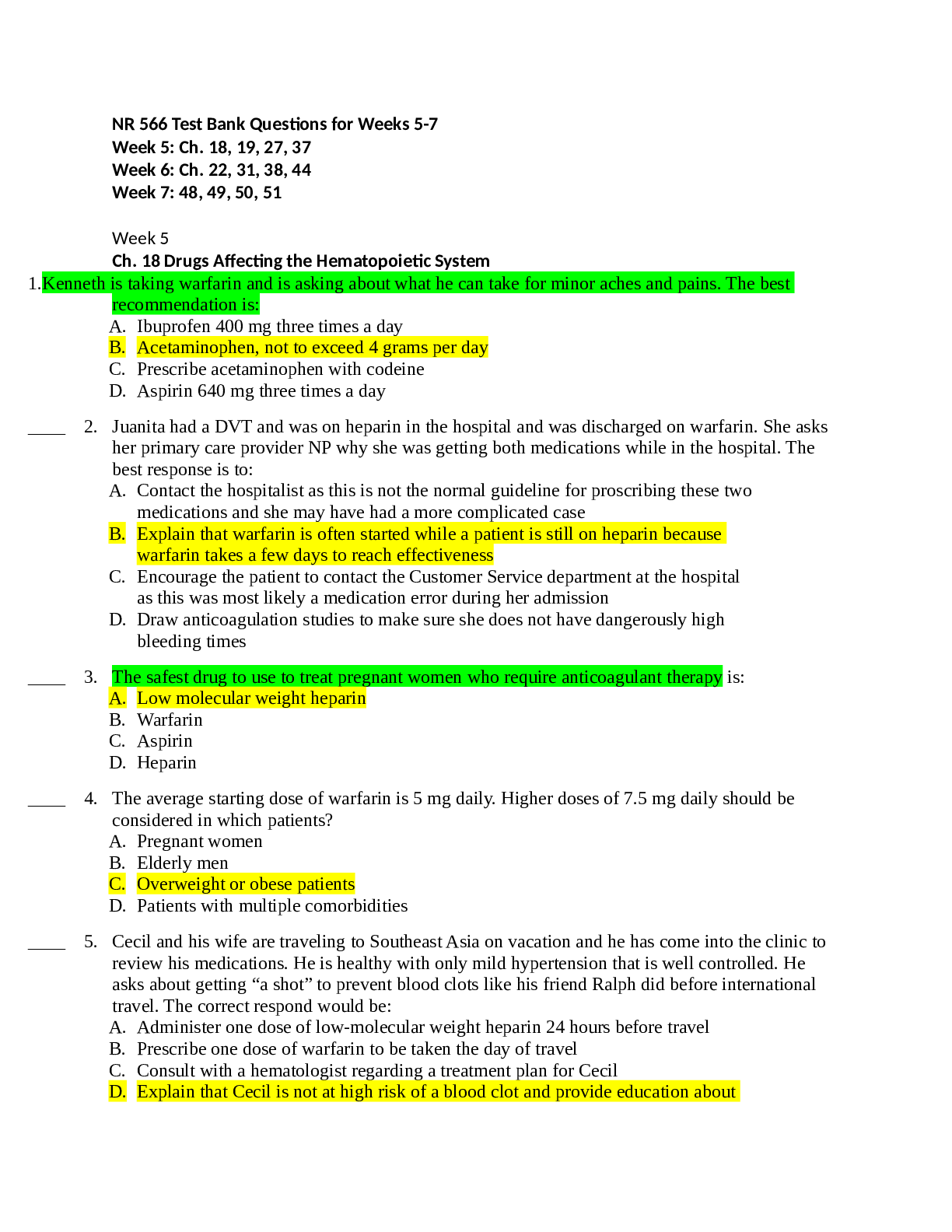
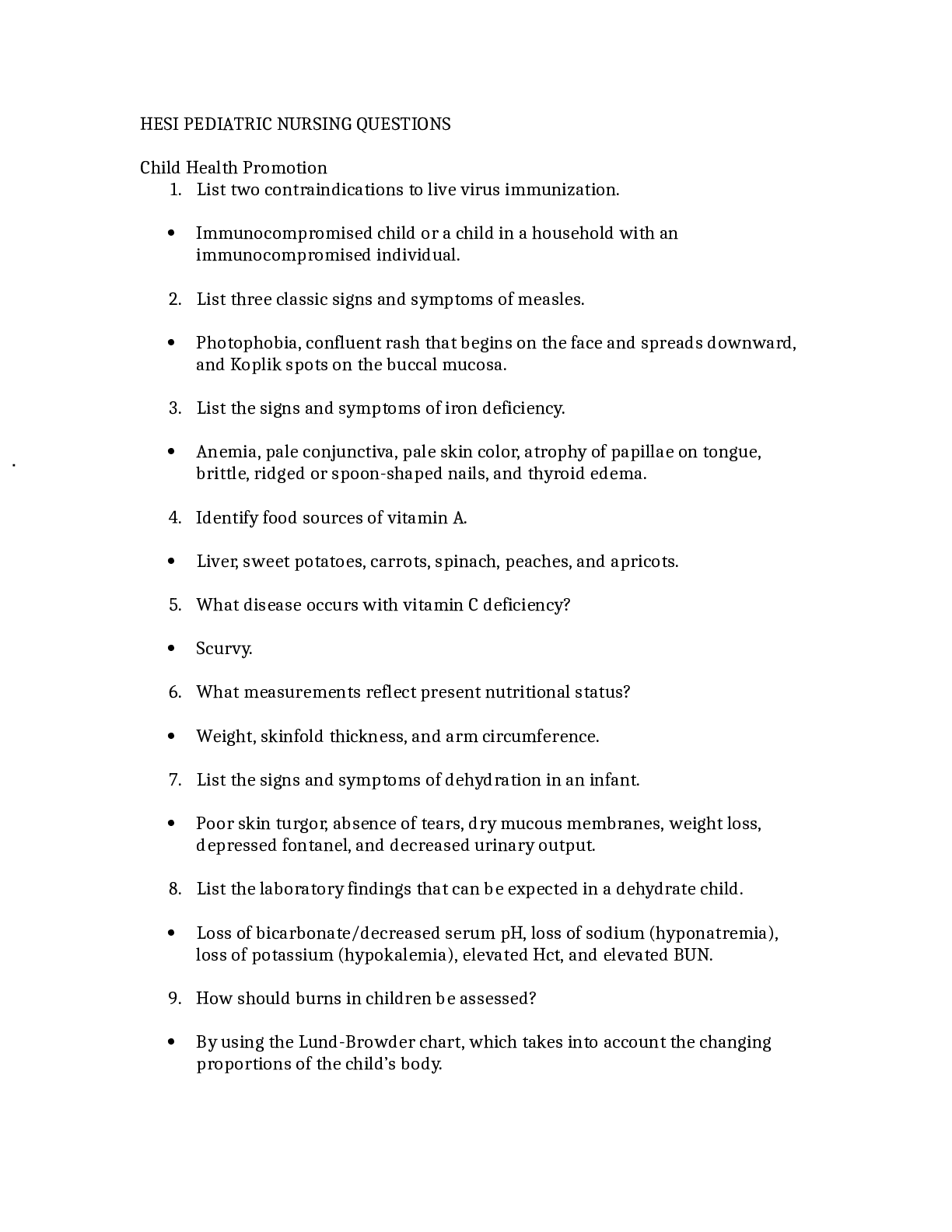
 (1).png)
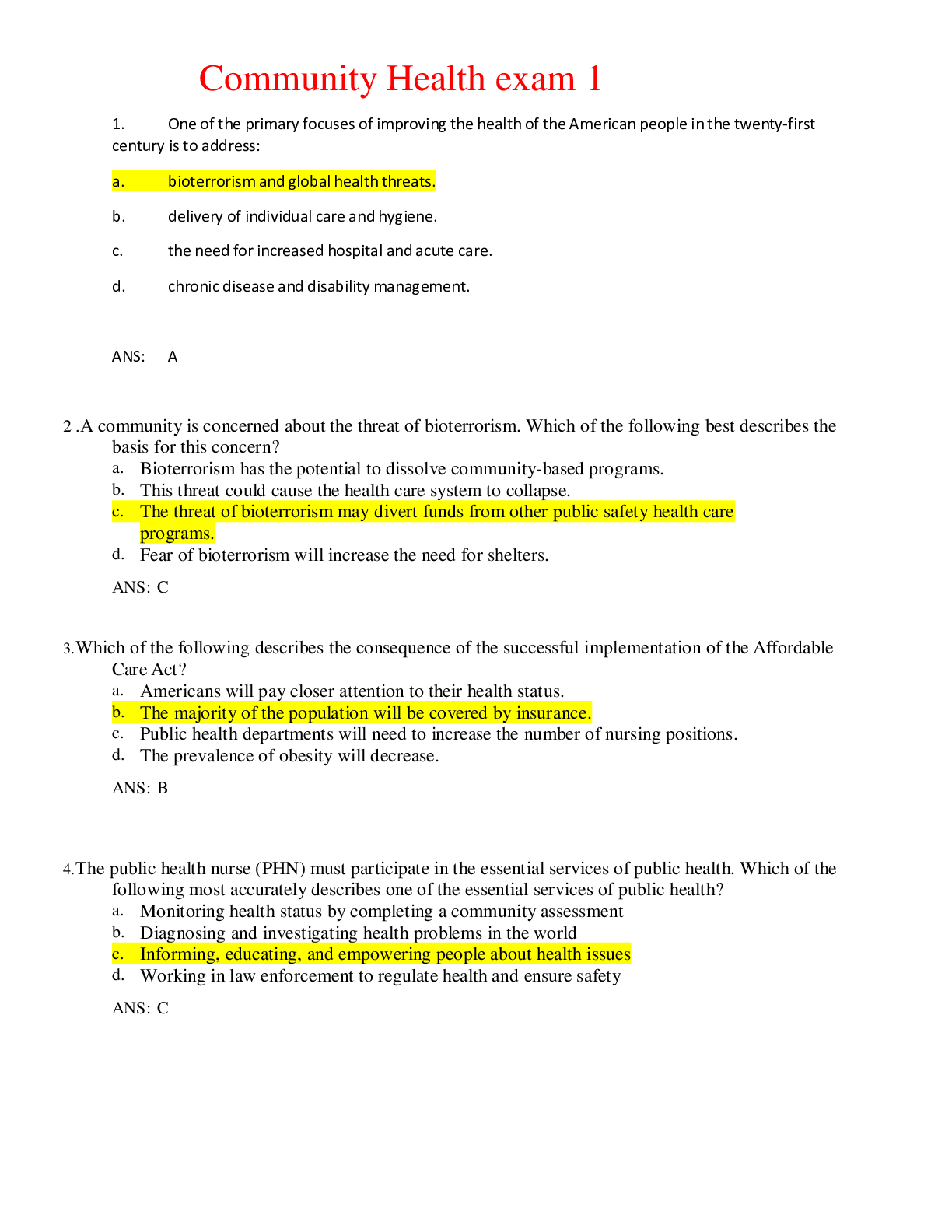


 (1).png)

